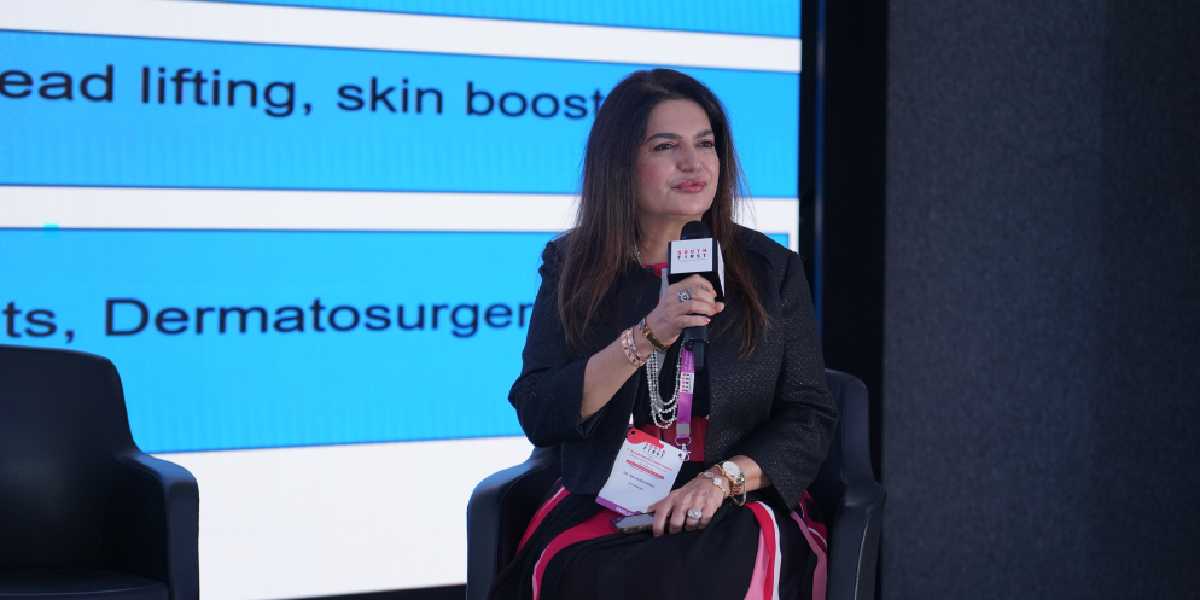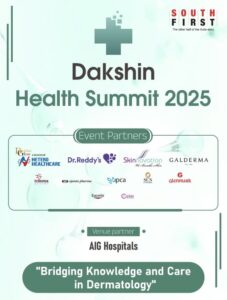Dr Kohli outlined five key molecular mechanisms driving the aging process: Cellular senescence, mitochondrial dysfunction, epigenetic alterations, DNA damage, and telomere shortening.
Published Nov 11, 2025 | 7:00 AM ⚊ Updated Nov 12, 2025 | 6:59 PM

Dr Malavika Kohali at the Dakshin Health Summit 2025. (South First)
Synopsis: During a panel discussion on “Skin Health & Aging”, leading dermatologists, endocrinologists, and nutritionists outlined how the race between cellular damage and repair mechanisms determines not just lifespan, but the health and appearance of our skin.
Medical experts have sounded the alarm on “inflammaging”, a newly recognised phenomenon where chronic inflammation drives the aging process at the second edition of South First’s Dakshin Health Summit held at the Asian Institute of Gastroenterology (AIG), Gachibowli, on Sunday, 9 November.
During a panel discussion on “Skin Health & Aging”, leading dermatologists, endocrinologists, and nutritionists outlined how the race between cellular damage and repair mechanisms determines not just lifespan, but the health and appearance of our skin.

The second edition of the Dakshin Health Summit 2025 was held at the Asian Institute of Gastroenterology in Hyderabad on Sunday, 9 November.
“Cell aging and renewal are really at the heart of how we understand aging today, and all our current mechanisms are directed toward this,” explained Dr Malavika Kohli, Senior Dermatologist and Director of Skin Secrets, Mumbai, who moderated the panel. “We know that the race is between the rate of damage and the rate of repair. Aging sets in when repair mechanisms can no longer keep up.”
Dr Kohli outlined five key molecular mechanisms driving the aging process: Cellular senescence, mitochondrial dysfunction, epigenetic alterations, DNA damage, and telomere shortening.
“All of it eventually comes down to inflammation. Inflammation is a silent epidemic,” she said.
The ramifications of chronic inflammation extend far beyond cosmetic concerns. “They contribute to chronic diseases, mental health issues, allergies, respiratory and digestive problems, joint issues, autoimmune conditions, and in dermatology it shows up as acne, eczema, psoriasis, rosacea, premature aging, and autoimmune disorders like lupus, rheumatoid arthritis, inflammatory bowel disease, and allergies,” Dr Kohli explained.
A significant revelation from the summit was the role of the gut-skin microbiome axis in healthy aging. “It is now well established that healthy skin begins with microbial homeostasis,” Dr Kohli said. “As we age, anti-inflammatory species in the gut decrease and pro-inflammatory bacteria increase. You essentially go from longevity-linked bacteria to those associated with inflammation.”
The panel explained that an impaired gut barrier allows pro-inflammatory products to leak through, driving systemic inflammation throughout the body. “Inflammation leading to aging is now well recognised as inflammaging,” Dr Kohli stated.
“What we commonly see in practice as dermatologists is insulin resistance, metabolic syndrome, and low vitamin D3,” said Dr Kohli. “We also notice that biomarkers such as ferritin, vitamin D3, fasting insulin, HbA1c, IL-6, CRP, and HSCRP are extremely important to assess inflammation.”
Dr Kalpana Sarangi, Consulting Dermatologist and Head of Department at Nanavati Hospital, Mumbai, confirmed that this understanding has changed clinical practice. “Certain skin conditions flare when there’s inflammation in the gut—psoriasis, rosacea, acne, even atopic dermatitis. So yes, we think differently now, but it’s not a rule. It’s not the rule,” she said.
Mrinal Pandit, Head Nutritionist at Oliva Skin Hair and Body, Hyderabad, described the current state of patient awareness: “When it comes to nutrition, it is almost always self-diagnosed. People come in thinking they already know. They’ve read things on Google, on ChatGPT these days, and if you don’t understand these concepts, they feel you’re outdated.”
She explained the protocol followed with clients: “We make sure probiotics and prebiotics are included. When we take their diet histories, we see there’s barely any fibre, no probiotics, none of it. So if someone is obese or feels they aren’t eating well, we start them on a general protocol. We supplement both through diet and through prebiotic and probiotic supplements.”
When asked to clarify the terms, Pandit explained: “A prebiotic is basically the food for the probiotic to feed on. Probiotics are the bacteria that feed on that and help increase the good flora in the body, which supports digestion and overall gut health.”
Dr Kohli noted the evolution in treatment approaches: “You also have moisturisers now that include prebiotic ingredients, which help balance the skin flora. You have to maintain that balance, whether it’s on the skin or in the gut. So this has become a co-prescription in today’s world.”
She also highlighted how dramatically food habits have changed: “It’s not just urbanisation. Food habits across the country have changed drastically.”
The panel included Dr Maya Vedamurthy, Senior Dermatologist and Director of RSV Skin Clinic, Chennai; Dr Lakshmi Lavanya, Endocrinologist and Diabetologist from Hyderabad; and Dr Jyotsna Gampa, Dermatologist and Trichologist, Director of Chaitanya Trichodermatology Clinics, Hyderabad.
(Edited by Sumavarsha)
